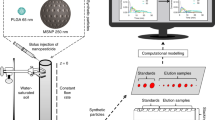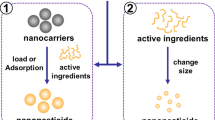Abstract
For the first time, regulatory protocols defined in the OECD guidelines were applied to determine the fate properties of a nanopesticide in two agricultural soils with contrasting characteristics. The nanoformulation studied had no effect on the degradation kinetics of atrazine indicating that (1) the release of atrazine from the polymer nanocarriers occurred rapidly relative to the degradation kinetics (half-lives 36–53 days) and/or that (2) atrazine associated with the nanocarriers was subject to biotic or abiotic degradation. Sorption coefficients, derived from a batch and a centrifugation technique at a realistic soil-to-solution ratio, were higher for the nanoformulated atrazine than for the pure active ingredient. Results indicate that the nanoformulation had an effect on the fate of atrazine. However, since the protocols applied were designed to assess solutes, conclusions about the transport of atrazine loaded onto the nanocarriers should be made extremely cautiously. The centrifugation method applied over time (here over 7 days) appears to be a useful tool to indirectly assess the durability of nanopesticides under realistic soil-to-solution ratios and estimate the period of time during which an influence on the fate of the active ingredient may be expected. More detailed investigations into the bioavailability and durability of nanopesticides are necessary and will require the development of novel methods suitable to address both the “nano” and “organic” characteristics of polymer-based nanopesticides.

Similar content being viewed by others
References
Addiscott TM (1977) Simple computer model for leaching in structured soils. J Soil Sci 28(4):554–563
Beulke S, Brown CD (2006) Impact of correlation between pesticide parameters on estimates of environmental exposure. Pest Manag Sci 62(7):603–609. doi:10.1002/ps.1198
Beulke S, van Beinum W (2012) Guidance on how aged sorption studies for pesticides should be conducted, analysed and used in regulatory assessments. http://www.pesticides.gov.uk/Resources/CRD/Migrated-Resources/Documents/E/EnvFate_Aged_sorption_guidance_final_30_07_2012.pdf. Accessed Sept 2013
Christian P, Von der Kammer F, Baalousha M, Hofmann T (2008) Nanoparticles: structure, properties, preparation and behaviour in environmental media. Ecotoxicology 17(5):326–343. doi:10.1007/s10646-008-0213-1
DEFRA (2010) Development of guidance on the implementation of aged soil sorption studies into regulatory exposure assessments. Research report for DEFRA project PS2235. The Food and Environment Research Agency and Alterra
Eisler R (2007) Atrazine. Eisler's encyclopedia of environmentally hazardous priority chemicals. Elsevier, Amsterdam
Eubeler JP, Bernhard M, Knepper TP (2010) Environmental biodegradation of synthetic polymers II. Biodegradation of different polymer groups. TrAC-Trends Anal Chem 29(1):84–100. doi:10.1016/j.trac.2009.09.005
FOCUS (2006) Guidance document on estimating persistence and degradation kinetics from environmental fate studies on pesticides in EU registration. Report of the FOCUS Work Group on Degradation Kinetics, EC document reference Sanco/ 10058/2005, version 2.0. FOCUS, Brussels, Belgium
Ford SC, Price OR, Terry AS (2007) Transport of pesticides to water from slow release formulations: application of current pesticide fate models. In: Del Re AAM, Capri E, Fragoulis G, Trevisan M (eds) Environmental fate and ecological effects of pesticides. La Goliarica Pavese, Pavia, IT
Gogos A, Knauer K, Bucheli TD (2012) Nanomaterials in plant protection and fertilization: current state, foreseen applications, and research priorities. J Agric Food Chem 60(39):9781–9792. doi:10.1021/jf302154y
Grillo R, AdE SP, Silva de Melo NF, Porto RM, Feitosa LO, Tonello PS, Dias Filho NL, Rosa AH, Lima R, Fraceto LF (2011) Controlled release system for ametryn using polymer microspheres: preparation, characterization and release kinetics in water. J Hazard Mater 186(2–3):1645–1651. doi:10.1016/j.jhazmat.2010.12.044
Grillo R, Pereira dos Santos NZ, Maruyama CR, Rosa AH, de Lima R, Fraceto LF (2012) Poly(epsilon-caprolactone)nanocapsules as carrier systems for herbicides: physico-chemical characterization and genotoxicity evaluation. J Hazard Mater 231:1–9. doi:10.1016/j.jhazmat.2012.06.019
Harper SS (1994) Sorption-desorption and herbicide behavior in soil. Rev Weed Sci 6:207–225
Kah M, Brown CD (2006) Adsorption of ionisable pesticides in soils. In: Ware GW (ed) Reviews of environmental contamination and toxicology, vol 188. Springer, New York, pp 149–217. doi:10.1007/978-0-387-32964-2_5
Kah M, Brown CD (2007) Changes in pesticide adsorption with time at high soil to solution ratios. Chemosphere 68(7):1335–1343. doi:10.1016/j.chemosphere.2007.01.024
Kah M, Hofmann T (2014) Nanopesticides research: current trends and future priorities. Environ Int 63:224–235. doi:10.1016/j.envint.2013.11.015
Kah M, Beulke S, Brown CD (2007) Factors influencing degradation of pesticides in soil. J Agric Food Chem 55(11):4487–4492. doi:10.1021/jf0635356
Kah M, Beulke S, Tiede K, Hofmann T (2013) Nanopesticides: state of knowledge, environmental fate and exposure modelling. Crit Rev Environ Sci Technol 43:1823–1867. doi:10.1080/10643389.2012.671750
Liu J, Legros S, Von der Kammer F, Hofmann T (2013) Natural organic matter concentration and hydrochemistry influence aggregation kinetics of functionalized engineered nanoparticles. Environ Sci Technol 47(9):4113–4120. doi:10.1021/es302447g
Martinazzo R, Jablonowski ND, Hamacher G, Dick DP, Burauel P (2010) Accelerated degradation of C-14-atrazine in Brazilian soils from different regions. J Agric Food Chem 58(13):7864–7870. doi:10.1021/jf100549d
Mudhoo A, Garg VK (2011) Sorption, transport and transformation of atrazine in soils, minerals and composts: a review. Pedosphere 21(1):11–25. doi:10.1016/s1002-0160(10)60074-4
OECD (2000) Guidelines for the testing of chemicals test no. 106: adsorption-desorption using a batch equilibrium method. Organisation for Economic Co-Operation and Development, Paris, France
OECD (2002) Guidelines for the testing of chemicals test no. 307: aerobic and anaerobic transformation in soils. Organisation for Economic Co-operation and Development, Paris, France
Ottofuelling S, Von der Kammer F, Hofmann T (2011) Commercial titanium dioxide nanoparticles in both natural and synthetic water: comprehensive multidimensional testing and prediction of aggregation behavior. Environ Sci Technol 45(23):10045–10052. doi:10.1021/es2023225
Pathak RK, Dikshit AK (2012) Atrazine and its use. Int J Res Chem Environ 2(1):1–6
Qing S, Yongli S, Yuehong Z, Ting Z, Haoyan S (2013) Pesticide-conjugated polyacrylate nanoparticles: novel opportunities for improving the photostability of emamectin benzoate. Polym Adv Technol 24(2):137–143. doi:10.1002/pat.3060
Schlichting E, Blume HP, Stahr K (1995) Bodenkundliches Praktikum. Blackwell, Berlin
Shaner D, Brunk G, Nissen S, Westra P, Chen WL (2012) Role of soil sorption and microbial degradation on dissipation of mesotrione in plant-available soil water. J Environ Qual 41(1):170–178. doi:10.2134/jeq2011.0187
United States Environmental Protection Agency (US EPA) (2013) http://www.epa.gov/pesticides/reregistration/atrazine/atrazine_update.htm. Accessed Sep 2013
University of Hertfordshire (2013) The Pesticide Properties DataBase developed by the Agriculture & Environment Research Unit, University of Hertfordshire, 2006–2013. http://sitem.herts.ac.uk/aeru/footprint/en/index.htm. Accessed Sep 2013
Viswanath NR, Patil RB, Rangaswami G (1977) Dehydrogenase activity and microbial population in a red sandy soil amended and unamended with incubation. Zentralblatt fuer Bakteriologie Parasitenkunde Infektionskrankheiten und Hygiene Zweite Naturwissenschaftliche Abteilung Allgemeine Landwirtschaftliche und Technische Mikrobiologie 132 (4):335-339
Walker A (2000) A simple centrifugation technique for the extraction of soil solution to permit direct measurement of aqueous phase concentrations of pesticide. In: Cornejo J, Jamet P (eds) Pesticide soil interactions-some current research, methods. pp 173–178
Walker A, Jurado-Exposito M (1998) Adsorption of isoproturon, diuron and metsulfuron-methyl in two soils at high soil : solution ratios. Weed Res 38(3):229–238
Walker A, Rodriguez-Cruz MS, Mitchell MJ (2005) Influence of ageing of residues on the availability of herbicides for leaching. Environ Pollut 133(1):43–51. doi:10.1016/j.envpol.2004.04.012
Yazgan MS, Wilkins RM, Sykas C, Hoque E (2005) Comparison of two methods for estimation of soil sorption for imidacloprid and carbofuran. Chemosphere 60(9):1325–1331. doi:10.1016/j.chemosphere.2005.01.075
Zablotowicz RM, Weaver MA, Locke MA (2006) Microbial adaptation for accelerated atrazine mineralization/degradation in Mississippi Delta soils. Weed Sci 54(3):538–547. doi:10.1614/ws-04-179r3.1
Acknowledgments
Renato Grillo and Leonardo Fernandes Fraceto would like to thank Grant #2009/00294-9 and #2011/01872-6, São Paulo Research Foundation (FAPESP), CNPq and Fundunesp.
Author information
Authors and Affiliations
Corresponding authors
Additional information
Responsible editor: Laura McConnell
Rights and permissions
About this article
Cite this article
Kah, M., Machinski, P., Koerner, P. et al. Analysing the fate of nanopesticides in soil and the applicability of regulatory protocols using a polymer-based nanoformulation of atrazine. Environ Sci Pollut Res 21, 11699–11707 (2014). https://doi.org/10.1007/s11356-014-2523-6
Received:
Accepted:
Published:
Issue Date:
DOI: https://doi.org/10.1007/s11356-014-2523-6




